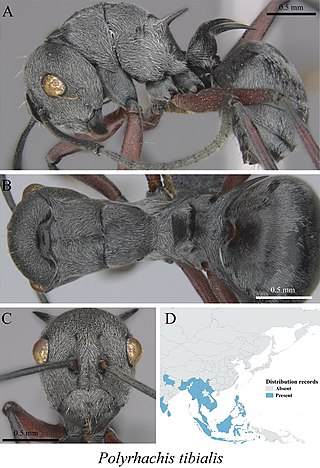
Tapinoma is a genus of ants that belongs to the subfamily Dolichoderinae. The genus currently comprises 74 described species distributed worldwide in tropical and temperate regions. Members of are generalized foragers, nesting in a wide variety of habitats, ranging from grasslands, open fields, woodlands, to inside buildings. The majority of species nest in the ground under objects such as stones or tree logs, other species build nests under bark of logs and stumps, in plant cavities, insect galls or refuse piles.

Crematogaster is an ecologically diverse genus of ants found worldwide, which are characterised by a distinctive heart-shaped gaster (abdomen), which gives them one of their common names, the Saint Valentine ant. Members of this genus are also known as cocktail ants because of their habit of raising their abdomens when alarmed. Most species are arboreal (tree-dwelling). These ants are sometimes known as acrobat ants.

Aenictus is a large army ant genus distributed in the Old World tropics and subtropics. It contains about 181 species, making it one of the larger ant genera of the world.

Technomyrmex is a genus of ants in the subfamily Dolichoderinae. With 98 species, it is one of the largest and most diverse ant genera in the Dolichoderinae. The genus distributed throughout the tropical and subtropical zones with most species occurring in the Oriental-Malesian and Afrotropical regions. One species, Technomyrmex albipes is a tramp ant now widespread throughout the tropics due to human activities.

Carebara is a genus of ants in the subfamily Myrmicinae. It is one of the largest myrmicine genera with more than 200 species distributed worldwide in the tropics and the Afrotropical region. Many of them are very tiny cryptic soil and leaf-litter inhabitants. They nest in rotten wood to which the bark is still adherent in the Afrotropical region, or may be lestobiotic nesting near other ant species. Some species are known to exist parasitically within termite nests. Little is known about the biology of the genus, but they are notable for the vast difference in size between queens and workers.

Lepisiota is an Old World genus of ants in the subfamily Formicinae. They nest in rotten wood, in standing trees or in the ground, generally in less forested areas.

Pseudolasius is a genus of ants in the subfamily Formicinae. The genus is known from southern Asia to northern Australia, where it appears to be restricted to tropical areas. These ants are commonly known as twig ants due to their habit of nesting in twigs or hollow stems.

Ectomomyrmex is a ponerine genus of ants found in Asia and Australia. Little is known about their biology, but they seem to be generalist predators of arthropod prey.

Ponerini is a tribe of Ponerinae ants with 46 genera and 6 extinct genera.
Camponotus irritans is a species of carpenter ant. It is found in many Asian and Oceanian countries.

Camponotus variegatus is a species of carpenter ant.

Crematogaster rogenhoferi is a species of ant of the subfamily Myrmicinae that can be found in Sri Lanka.

Polyrhachis hippomanes is a species of ant in the subfamily Formicinae, found in Sri Lanka. Three subspecies are recognized. 2 subspecies were given full species status recently.

Polyrhachis tibialis is a species of ant in the subfamily Formicinae, found in many Asian countries. There are 10 subspecies recognized.

Diacamma rugosum, also known as the Bornean queenless ant, is a species of ant of the subfamily Ponerinae. It is found in many countries throughout Southeast Asia. 20 subspecies are recognized.














